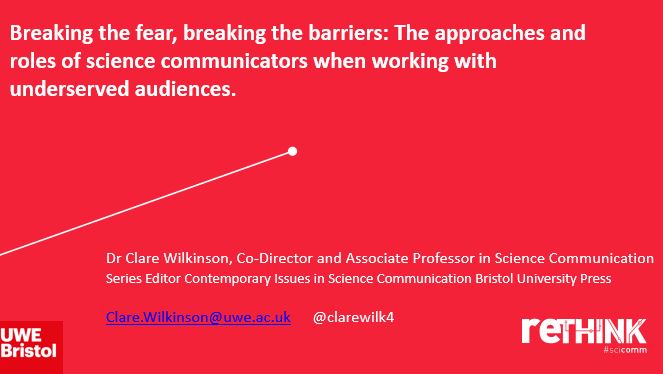Breaking the fear, breaking the barriers: The approaches and roles of science communicators when working with underserved audiences.

Inclusive science communication, or inclusive scicomm, is a global movement to shift the traditional paradigm of science communication toward an approach that centers inclusion, equity, and intersectionality. The biennial symposium is an international convening of practitioners, trainers, researchers, educators, funders, and others who work across diverse disciplines and settings to prioritize inclusion, equity, and intersectionality in all forms of science communication. View the ISCS21 Agenda at a Glance.
A survey of science communicators across Europe conducted within RETHINK showed that relatively few of those who communicate science (29%, n=465) seek to reach audiences who would be considered ‘underserved’ with their activities (Milani et al. 2020a). This presentation explored the result of interviews conducted with 32 science communicators in Italy, the Netherlands, Poland, Portugal, Serbia, Sweden and the UK who had indicated that they sought to reach underserved audiences. They work as press officers, writers and journalists, researchers who communicate about their work, as well as public engagement officers. Interviewees described a wide range of audiences they considered or found harder to engage, such as those from certain socioeconomic backgrounds, older people, younger people, local communities, as well as those disinterested in science.
This presentation highlighted the approaches science communicators designed and undertook to change the dynamic between scientists and citizens, as well as roles being adopted by some of today’s science communicators that may help to foster connections with new audiences. It is now well-documented that when science is communicated, audiences are most typically white, affluent, with relatively high levels of formal education and a pre-existing interest in science (Dawson, 2019; Kennedy, Jensen and Verbeke, 2017; Humm, Schrögel and Leßmöllmann, 2020). The presentation focused on some of the practical steps being taken by science communicators to create closer connections between science and all members of society, so that the future trajectory of science may be informed by citizens as well as the scientific community.
